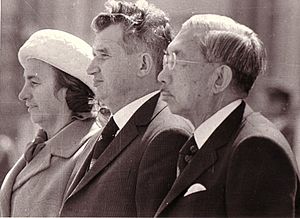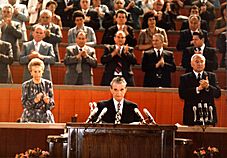Elena Ceaușescu facts for kids
Quick facts for kids
Elena Ceaușescu
|
|
|---|---|
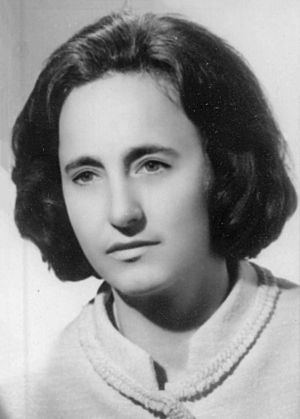
Elena in 1939
|
|
| First Deputy Prime Minister of Romania | |
| In office 29 March 1980 – 22 December 1989 |
|
| President | Nicolae Ceaușescu |
| Prime Minister | Ilie Verdeț Constantin Dăscălescu |
| Preceded by | Gheorghe Oprea |
| Succeeded by | Mihai Drăgănescu |
| President of the Council of National Science and Technology | |
| In office 8 April 1980 – 22 December 1989 |
|
| Prime Minister | Ilie Verdeț Constantin Dăscălescu |
| Preceded by | Ioan Ursu |
| Succeeded by | Office abolished |
| First Lady of Romania | |
| In role 28 March 1974 – 22 December 1989 |
|
| President | Nicolae Ceaușescu |
| Preceded by | Position established |
| Succeeded by | Nina Iliescu |
| Personal details | |
| Born |
Lenuța Petrescu
7 January 1916 Petrești, Dâmbovița County, Kingdom of Romania |
| Died | 25 December 1989 (aged 73) Târgoviște, Dâmbovița County, Socialist Republic of Romania |
| Cause of death | Execution by firing squad |
| Resting place | Ghencea Cemetery, Bucharest, Romania |
| Political party | Romanian Communist Party |
| Spouse | |
| Children |
|
Elena Ceaușescu was a powerful Romanian politician. She was married to Nicolae Ceaușescu, who was the leader of Romania for many years. She became a very important person in the Romanian government. She was even the Deputy Prime Minister of Romania.
Contents
Early Life and Family
Elena was born Lenuța Petrescu on January 7, 1916. Her family lived in a small village called Petrești in Romania. Her father was a farmer.
She only went to elementary school. After school, she moved to Bucharest with her brother. She worked in a lab and then in a textile factory.
In 1939, she joined the Romanian Communist Party. This is where she met Nicolae Ceaușescu. He was 21 years old. They fell in love and got married on December 23, 1947.
Rise to Power
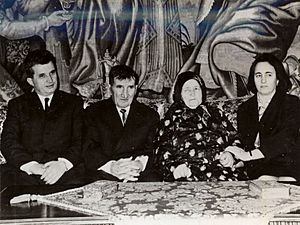
After the Communist Party took control of Romania, Elena started working in the government. At first, she was not a very important figure. But this changed when her husband, Nicolae, became the leader of the Communist Party.
Elena often traveled with her husband on official trips to other countries. In 1971, she visited China. There, she saw how Jiang Qing, the wife of China's leader Mao Zedong, had a lot of power. This visit seemed to inspire Elena to gain more power herself in Romania.
Soon after, Elena began to get many important jobs in the Romanian Communist Party. By 1973, she became a member of the Politburo. This made her the second most powerful person in Romania, right after her husband. She was very involved in running the party.
In 1975, she was elected to the Great National Assembly. This was Romania's main law-making body. She held this position until her death. In 1980, she became the First Deputy Prime Minister. This was a very high government position.
From the 1980s, Elena was praised a lot by the government. She was even called the "Mother of the Nation." People had to be very careful when showing her on TV. For example, she was never shown from the side because of her nose.
End of Power
In December 1989, there was a big uprising in Romania called the Romanian Revolution. Elena and her husband tried to escape. But they were caught in a town called Târgoviște.
They were put on trial. Elena answered only a few questions. Her husband tried to protect her and told her to stay calm.
Death
On December 25, 1989, Elena Ceaușescu and her husband were executed. She was 73 years old. She was the only woman in modern Romania to be executed by the state.
Elena was buried in Ghencea Cemetery in Bucharest. She had three children: Valentin, Zoia, and Nicu.
Chemistry Research Claims
Elena Ceaușescu was said to be a scientist. She got a degree in chemistry and was awarded a PhD. She also worked at a chemical research institute.
However, after 1989, many scientists said that Elena had forced them to write papers and research in her name. They claimed that she received her degrees and honors only because of her powerful position.
There were rumors that a famous chemist did not want to give her a doctorate. So, she had to get it from another university. Her PhD paper was about a type of plastic. Even though she only went to elementary school, the paper was very advanced. People believe others wrote it for her.
She was sometimes called "Codoi." This nickname came from how she supposedly mispronounced the chemical name for Carbon dioxide (CO2). In Romanian, "doi" means "two." But "codoi" also means "big tail," which made the nickname funny to many.
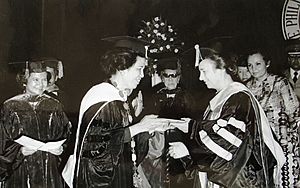
Elena received many awards for her supposed scientific work. She was even listed as an inventor on some patents. But many scientists said she forced them to share credit with her.
Some scientists today are trying to remove her scientific credentials. They argue that her work, which they say she didn't write, is still being cited in real scientific papers. In 1978, a British chemistry group made her a member. But they removed her membership during the Romanian Revolution in 1989.
Awards and Honors
Elena Ceaușescu received many awards and honorary degrees from different countries and universities around the world. These included:
- Iran: Commemorative Medal (1971)
- Italy: Grand Cross of the Order of Merit (1973)
- Argentina: Grand Cross of the Order of the Liberator General San Martín (1974)
- Portugal: Grand Collar of the Order of Prince Henry (1975)
- Philippines: Order of Gabriela Silang (1975)
- Malaysia: Honorary Grand Commander of the Order of the Defender of the Realm (1984)
Honorary Degrees and Professorships
She was also given honorary doctorates and was made a member of several academic groups:
- Member of the New York Academy of Sciences (USA, 1973)
- Corresponding member of the Academy of Athens (Greece, 1976)
- Honorary Doctor from the University of Buenos Aires (Argentina, 1974)
- Honorary Doctor from Philippine Women's University (1975)
- Honorary Professor at the National University of Engineering (Peru, 1973)
- Honorary Member of the American Institute of Chemists (USA, 1973)
- Honorary Professor at the Polytechnic of Central London (1978)
See also
 In Spanish: Elena Ceaușescu para niños
In Spanish: Elena Ceaușescu para niños


